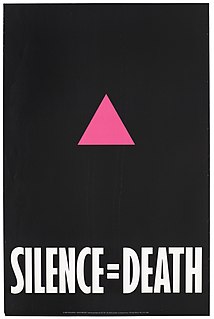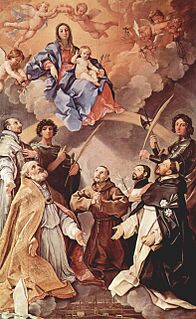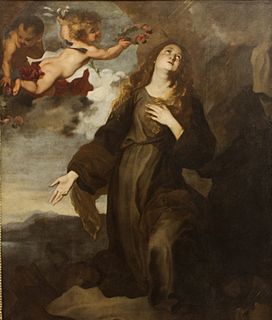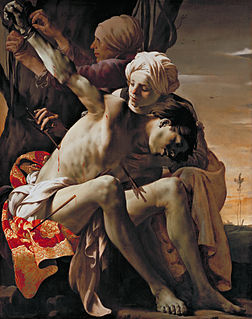 W
WThe AIDS pandemic began in the early 1980s and brought with it a surge of emotions from the public, they were afraid, angry, fearful, and defiant. The arrival of AIDS also brought with it a condemnation of the LGBT community. These emotions, along with the view on the LGBT community, paved the way for a new generation of artists. Artists involved in AIDS activist organizations had the ideology that while art could never save lives as science could, it may be able to deliver a message. Art of the AIDS crisis typically sought to: make a sociopolitical statement, stress the medical impact of the disease, or express feelings of longing and loss. The ideologies were present in conceptions of art in the 1980s and are still pertinent to reception of art today as well. Elizabeth Taylor, for example, spoke at a benefit for AIDS involving artwork, emphasizing its importance to activism in that, "art lives on forever." This comment articulates the ability of artwork from this time to teach and impact contemporary audiences, post-crisis. This page examines the efforts of artists, art collectives, and art movements to make sense of such an urgent pandemic in American society.
 W
WBonaparte Visits the Plague Stricken in Jaffa is an 1804 painting commissioned by Napoleon Bonaparte and painted by Antoine-Jean Gros portraying an event during the French invasion of Egypt. The scene shows Napoleon during a striking scene which is supposed to have occurred in Jaffa on 11 March 1799, depicting the French general making a visit to his ill soldiers at the Armenian Saint Nicholas Monastery.
 W
WChrist appointing Saint Roch as patron saint of plague victims or The Plague Victims is a 1623–1626 altarpiece by Peter Paul Rubens. It is located in the Sint-Martinuskerk in Aalst, Belgium and shows Saint Roch.
 W
WCrack Is Wack is a mural created in 1986 by American artist and social activist Keith Haring. Located near the Harlem River Drive in East Harlem, the mural serves as a warning against crack cocaine use, which was rampant in major cities across the United States during the mid to late 1980s. As a symbol of anti-drug activism, Crack Is Wack commemorates Haring's powerful sociopolitical presence as an artist and remains a part of New York City's vast repertoire of iconic public art.
 W
WThe Danse Macabre, also called the Dance of Death, is an artistic genre of allegory of the Late Middle Ages on the universality of death: no matter one's station in life, the Danse Macabre unites all.
 W
WLa Habanera is a 1937 German romantic melodrama feature film directed by Detlef Sierck. Zarah Leander, who was recently signed by UFA, stars, in the lead role of Astrée Sternhjelm and also performs its title song, "La Habanera". Like many of her films of this era, it proved an enormous box office success.
 W
WThe Isenheim Altarpiece is an altarpiece sculpted and painted by, respectively, the Germans Nikolaus of Haguenau and Matthias Grünewald in 1512–1516. It is on display at the Unterlinden Museum at Colmar, Alsace, in France. It is Grünewald's largest work, and is regarded as his masterpiece. It was painted for the Monastery of St. Anthony in Issenheim near Colmar, which specialized in hospital work. The Antonine monks of the monastery were noted for their care of plague sufferers as well as their treatment of skin diseases, such as ergotism. The image of the crucified Christ is pitted with plague-type sores, showing patients that Jesus understood and shared their afflictions. The veracity of the work's depictions of medical conditions was unusual in the history of European art.
 W
WThe Massacre at Chios is the second major oil painting by the French artist Eugène Delacroix. The work is more than four meters tall, and shows some of the horror of the wartime destruction visited on the Island of Chios in the Chios massacre. A frieze-like display of suffering characters, military might, ornate and colourful costumes, terror, disease and death is shown in front of a scene of widespread desolation.
 W
WThe Miracles of St. Francis Xavier is a large altarpiece painted by Peter Paul Rubens in 1617 or 1618. It was originally commissioned by the Jesuits in Antwerp for their church, now known as the St. Charles Borromeo Church. It is now in the Kunsthistorisches Museum in Vienna. The painting depicts the miracles worked by St. Francis Xavier during his mission to Asia and includes a large variety of figures from Asia and Africa, as well as the destruction of a Hindu idol in the background. Rubens also painted a companion piece, The Miracles of St. Ignatius of Loyola.
 W
WThe Pala della Peste or Pallione del Voto is a Baroque-style altarpiece by Guido Reni depicts the Madonna and Child in Glory with the Patron Saints of Bologna: Petronius, Francis, Ignatius, Francis Xavier, Proculus of Bologna, and Florian. The painting is oil on silk.
 W
WPlague is an 1898 painting in tempera by the Swiss symbolist artist Arnold Böcklin, held in the Kunstmuseum Basel. It exemplifies the artist's obsession with nightmares of war, pestilence and death. The painting shows Death riding on a bat-like winged creature, who travels through the street of a medieval European town.
 W
WThe Plague of Ashdod is also known as The Miracle of the Ark in the Temple of Dagon, by the French artist Nicolas Poussin. The painting represents a story from 1 Samuel in the Old Testament. The original painting currently hangs in the Louvre in Paris. Poussin was commissioned to paint The Plague of Ashdod by Fabrizio Valguarnera. Fabrizio Valguarnera was a Sicilian merchant who was put on trial for laundering money through the purchase of this painting; he also commissioned more than one version of this piece. Poussin painted this during a plague that took place in Italy from 1629 to 1631, which influenced his accurate portrayal of the epidemic.
 W
WSaint Januarius Interceding or Saint Januarius Interceding to the Virgin Mary, Christ and God the Father for Victims of the Plague is an oil on canvas painting by Luca Giordano. It is dated to around 1656 and is now in the National Museum of Capodimonte in Naples. It was commissioned by the Spanish viceroy in Naples, Gaspare de Bracamonte, as an ex voto for the ending of a plague in the city.
 W
WSaint Roch Interceding with the Virgin for the Plague-Stricken is an early religious painting by the French artist Jacques-Louis David. It shows Saint Roch interceding to the Virgin Mary and Christ Child for the plague sufferers shown around him. He painted it in 1780 during his stay at the Villa Medici in Rome after winning first prize for painting in the Prix de Rome and exhibited it at the 1781 Paris Salon on his return to France. While in Rome he was much influenced by the works of Caravaggio, Poussin, Guercino and Lebrun. He was determined not to be seduced by the Italian baroque style, declaring "the Antique will not seduce me, it lacks animation, it does not move". Nevertheless, he filled twelve sketchbooks with drawings while he was in Rome, and he and his studio used them as models for the rest of his life.
 W
WSaint Rosalia is a c.1625 oil on canvas painting by Anthony van Dyck. Originally owned by Giovan Francesco Serra di Cassano, it was bought by Philip IV of Spain via his Viceroy of Naples Gaspar de Bracamonte in 1664 and is now in the Museo del Prado in Madrid
 W
WSaint Rosalia Crowned by Angels is a c.1625 oil on canvas painting by Anthony van Dyck, one of five surviving works showing the saint which he produced whilst he was quarantined in Palermo, Sicily due to a plague. It is now in the Menil Collection in Houston, Texas, which bought it in 1968. It was loaned from there in 2011-2012 to the Dulwich Picture Gallery in London.
 W
WSaint Rosalia Crowned by Angels is a c.1625 oil on canvas painting by Anthony van Dyck, one of five surviving works showing the saint which he produced whilst he was quarantined in Palermo, Sicily due to a plague. It is now in the Wellington Collection at Apsley House in London.
 W
WSaint Rosalia Crowned by Angels is a c.1624 oil on canvas painting by the studio of Anthony van Dyck, one of several works showing the saint produced whilst van Dyck was quarantined in Palermo, Sicily due to a plague. It is now in the Galleria Regionale del Palazzo Abatellis in Palermo, where in 2015 it was displayed alongside Saint Rosalie Interceding, loaned from the Metropolitan Museum of Art.
 W
WSaint Rosalia Interceding for the City of Palermo is an oil on canvas painting of Saint Rosalia by Anthony van Dyck, now in the Museo de Arte de Ponce in Puerto Rico, which acquired it at auction at Sotheby's in London on 7 December 1960. It is sometimes dated to 1629 when the artist was back in Antwerp and sometimes to 1624-1625 whilst the artist was quarantined in Palermo, Sicily.
 W
WSaint Rosalie Interceding for the Plague-stricken of Palermo is a painting of 1624 by Anthony van Dyck, in the Metropolitan Museum of Art in New York since 1871.
 W
WSt. Sebastian is the subject of three paintings by the Italian Early Renaissance master Andrea Mantegna. The Paduan artist lived in a period of frequent plagues; Sebastian was considered protector against the plague as having been shot through by arrows, and it was thought that plague spread abroad through the air.
 W
WSaint Sebastian Tended by Saint Irene is an incident in the legends of Saint Sebastian and Saint Irene of Rome. It was not prominent in the hagiographical literature until the late Renaissance, and is hardly seen in art before then. As an artistic subject, normally in painting, it suddenly became popular from the 1610s, though found in predella scenes as early as the 15th century, and was most popular until about the 1670s.
 W
WSaint Sebastian Tended by Irene is an oil-on-canvas painting by Hendrick ter Brugghen dated to 1625. Now in the Allen Memorial Art Museum of Oberlin, Ohio, the piece depicts the Roman Catholic subject of Saint Sebastian Tended by Saint Irene, after Irene of Rome and her maid rescued him following his attempted martyrdom by the Roman authorities. An exemplary piece of the Italianate Baroque tendency in Dutch Golden Age painting, the painting employs dramatic uses of light and skillful chiaroscuro to depict its religious subject, evidence of influence from Caravaggio and Ter Brugghen's fellow Utrecht Caravaggisti.
 W
WSaints Roch, Anthony Abbot and Lucy or Three Saints is a 1513 oil on canvas painting by Cima da Conegliano, which is now in the collection of the Metropolitan Museum of Art in New York.
 W
WSanta Maria della Salute, commonly known simply as the Salute, is a Roman Catholic church and minor basilica located at Punta della Dogana in the Dorsoduro sestiere of the city of Venice, Italy.
 W
WTodos Juntos Podemos Parar el SIDA is a mural created by American artist and social activist Keith Haring in 1989. The mural was painted to raise awareness to the Aids epidemic. It is located next to the Museu d'Art Contemporani de Barcelona museum in the El Ravel neighborhood of Barcelona.
 W
WThe Triumph of Death is an oil panel painting by Pieter Bruegel the Elder painted c. 1562. It has been in the Museo del Prado in Madrid since 1827.